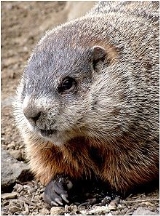Is there a way by looking at a groundhog to identify whether it is a male or female?
replied to: alvee
Replied to: Is there a way by looking at a groundhog to identify...
I have a female...or at least I THINK she's a she, but now that you've posed the question, I've never seen another close enough to compare, so IS she a she???
Well, she has HUGE boobs and has no noticeable man parts. Looking at a pair in a field or something, I don't know if you could tell by size or not.
Debrann
i just joined or would have answered much sooner.
My groundhogs' name is Daisy and she lives in a cat cube under my bed.
replied to: alvee
Replied to: Is there a way by looking at a groundhog to identify...
GROUNDHOG
Marmota monax
Buddy, a male groundhog, came to Cedar Run in the spring of 2001. He was found shivering and hungry in a family's backyard. A car had killed his mother and sisters.
The people who found Buddy kept him for several weeks, but groundhogs (like other wild animals) do not make good pets. During that time, he became imprinted and lost his fear of humans. For that reason, Buddy cannot be returned to the wild.
Since it is difficult to tell the sex of an immature groundhog, for about a year Buddy was known as "Rosebud"!
--------------------------------------------------------------------------------
Groundhog Facts
Also called woodchucks or whistle pigs
Large, stout-bodied, short-legged mammal
Closely related to squirrels
Common New Jersey resident
Found in fields, woodlots, open forests, and clearings near roadsides.
Expert digger that constructs multi-room underground burrow
Is diurnal, or active during the daytime (early morning and late afternoon)
Is a herbivore, or vegetarian, eating a wide variety of wild plants, clover and alfalfa, and garden vegetables if available.
Able to climb trees and swim.
Will whistle loudly to warn of danger and also may chatter, hiss, and growl.
Never travels far from its burrow and will dive into it for cover when alarmed
Solitary animal, except for mothers with babies
Two to seven young are born in April or May.
Is a "true" hibernator, surviving solely on stored body fat throughout winter
Lifespan: 6 years in the wild, 10 years in captivity

